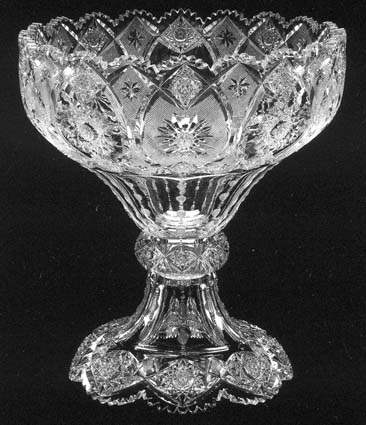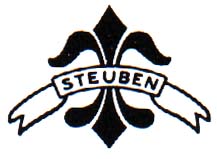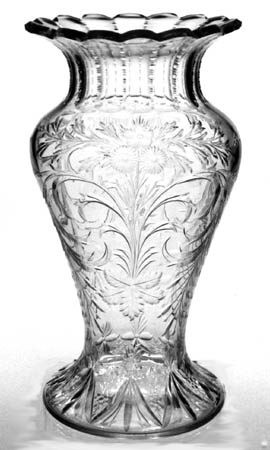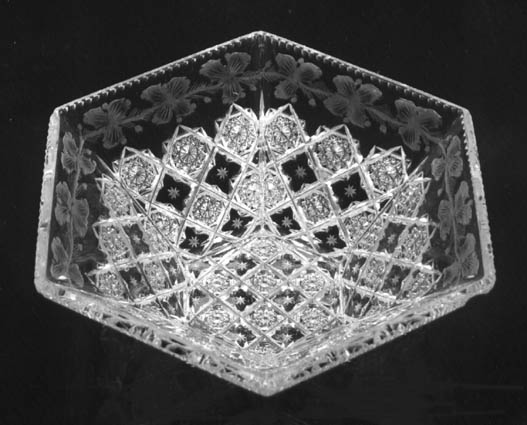H. P. Sinclaire & Company
American Brilliant Glass Education and Research - HBG
Two-Part Punch Bowl Cut in an Unidentified Pattern by H. P. Sinclaire & Company
This geometric example is taken from a postcard printed by the Corning Museum of Glass (out-of-print, not copyrighted). This image is also shown in Spillman, 1996 (p. 291). The museum acquired the punch bowl in 1986. Signed Sinclaire. H = 16.1″ (41.0 cm).

Historical Sketch, Trademarks, and Catalogs
When H. P. Sinclaire, Jr. opened his cutting shop in Corning, NY in 1904 the business was well-positioned to become a successful enterprise, not least because American cut glass had reached the apex of its popularity at about this time. But other factors also predicted a successful future, factors that centered on “H. P.” himself. The man, personable and good-looking, had an excellent, although informal, liberal arts education through use of his father’s extensive personal library. More formally, he received practical training at the Rochester (NY) Business Institute, training that enabled him to assume the title of book-keeper at Hawkes Rich Cut Glass Works in 1883. At this company he was trained in all aspects of glass-making by T. G. Hawkes himself, and eventually he assumed increased responsibility in the management of the company.
H. P.’s artistic ability, evident from an early age, was encouraged at the Hawkes company where he designed the engraved glass that the company displayed at the Paris Exposition in 1889. The following year he “became the only other owner of more than one share of stock” in the re-organized company now called T. G. Hawkes & Company. (Hawkes was, of course, the other owner.) At this time “Hawkes and Sinclaire agreed about little. Hawkes preferred rich-cut glass, for examples; Sinclaire loved engraving.” (Sinclaire and Spillman 1997, p. 206). Estelle Sinclaire has written about these years in detail in the foregoing reference, and also in a monograph, writing as Estelle Sinclaire Farrar (1974 and 1975).
After C. Dorflinger & Sons — a major supplier of blanks for H. P. Sinclaire & Company — closed in 1920, Sinclaire opened a glass-blowing factory in Bath, NY, moving it to Dunkirk, NY in 1925. H.P. died suddenly in 1927, and the Dunkirk factory closed immediately. Glass cutting continued at the Corning shop until the following year when the entire company closed.
Principal sources: Farrar (1974), Spillman (1996), Sinclaire and Spillman (1997)
Trademarks
For many years KOVELS’ ANTIQUES & COLLECTIBLES PRICE LIST has given collectors the impression that Sinclaire cut glass was not often “signed”, and this mistaken notion persists. Additionally, it gained credence because imperfect pieces were not signed but were sold rather than destroyed which was the policy of many glass manufacturers. Sinclaire and Spillman (1997, p. 223) describe this situation as follows:
Corningites bought and subsequently repaired hundreds, perhaps thousands, of these [imperfect] pieces. Their present owners are likely to think, incorrectly, that Sinclaire & Co. glass was never signed. Unlike Hawkes & Co. and Hoare & Co., Sinclaire & Co. used a trademark from the first [year of operation, 1904]. Unsigned glass in Sinclaire & Co. designs should be considered either imperfect or a “matching” from another company. An exception to this rule is Sinclaire & Co. glass signed by a jewelry company. Some leading jewelers insisted on using their own trademarks on glass that they sold.
In the writer’s experience Sinclaire cut glass is usually signed, but an extra effort is sometimes required to locate the signature. The laurel wreath trademark, greatly enlarged below, is often so small that it can easily escape notice. An actual example is also shown below. SINCLAIRE, acid-etched in block letters, which was also used as a trademark, is not confined to stemware as is sometimes stated. It can be “hidden” near the rim of a dish, for example. (The Steuben trademark is also shown here because the S-in-a-wreath Sinclaire mark is sometimes incorrectly interpreted by novice collectors as the signature of the Steuben Glass Works. Steuben cut glass is not found with this acid-etched trademark, but STEUBEN in block letters, acid-etched on some engravings, has been reported.)


Catalogs
[100-Plate Photographic Inventory, c1917] Plates 1-66 are found in H. P. SINCLAIRE, JR., GLASSMAKER by Estelle Sinclaire Farrar, Vol. 1, 1974, Farrar Books, Garden City, NY. (Plates 67-100 are shown in Sinclaire & Spillman, 1997, pp. 224-257). Vol. 2, 1975, of H. P. SINCLAIRE, Jr., GLASSMAKER contains a listing of blanks (shapes) used by the company. Vols. 1 and 2 are out-of-print.
[Additional patterns – drawings] Spillman 1996, pp. 307-310.
Vase Engraved in the RC Somerset Pattern by H. P. Sinclaire & Company
The following example is typical of the rock-crystal style produced by Sinclaire about 1915. Note the usually low selling price. Although advertised for several months, the failure of this item to find a buyer at a higher price can be taken as an indication of the low regard that many of today’s collectors have for engraved glassware.
Vase engraved in the RC Somerset pattern, on shape no. 3123, by H. P. Sinclaire & Co., c1915. H = 12.0″ (30.5 cm), max D = 6.5″ (16.5 cm), wt = 4.25 lb (1.9 kg). Ground and polished pontil contains the acid-stamped Sinclaire “wreath” trademark. Sold for $50 in 1986.

The Patented Patterns (1909-1916)
All patents were assigned to the company by Henry P. Sinclaire, except those marked with an asterisk (*) which were retained by the patentee.
Patent No. / Catalog or “Coined” Name / Patentee / Application Filed / Date Granted
39,980 / Engraved No. 8 / Henry P. Sinclaire / 21 Jan 1909 / 4 May 1909
40,196 / Assyrian / Henry P. Sinclaire / 3 Jun 1909 / 3 Aug 1909
40,603 / Flutes & Panel Border / Henry P. Sinclaire / 4 Feb 1910 / 5 Apr 1910
41,204 / Snow Flakes & Holly / Henry P. Sinclaire / 30 Dec 1910 / 28 Feb 1911
44,774 / Diamonds & Silver Threads / Henry P. Sinclaire / 16 Aug 1913 / 21 Oct 1913 (*) (note 1)
47,411 / Adam / Henry P. Sinclaire / 23 Feb 1915 / 1 Jun 1915 (*) (note 2)
47,412 / Georgian / Henry P. Sinclaire / 23 Feb 1915 / 1 Jun 1915 (*)
48,765 / (shape only: salad-dressing bottle) / Henry P. Sinclaire / 27 Jan 1916 / 21 Mar 1916
49,479 / Stratford / Henry P. Sinclaire / 27 Mar 1916 / 1 Aug 1916 (*)
The last five patents, above, are not included in Revi (1965). Their images can be found in the correction file for Revi’s book (the revi1.htm file in Part 1).
NOTES:
1. This pattern, when realized, usually varies from the patented design — for example, the silver threads are parallel, not divergent, and a band of short flutes is sometimes added. Spillman (1996, p. 290) incorrectly calls the pattern “Silver Diamonds and Silver Threads”. Elsewhere, the Sinclaire photo-inventory refers to these diamonds as “strawberry diamonds”, the name that is given (correctly) to the cross-cut diamond motif when it is used, in whole or in part, as the name of a pattern. Silver diamonds, on the other had, refers to the strawberry (or fine) diamond motif when this cutting is used, again in whole or in part, as a pattern name, principally by C. Dorflinger & Sons. It is a propriatory name and, therefore, should not be used as a synonym for strawberry (fine) diamonds. In any case the “silver-diamond” motif does not appear in this patented design.
2. Farrar (1974, p. 38) indicates that Adam No. 2 was patented. However, a search of the patent indicies for 1915 and 1916, kindly undertaken for the writer by the Reference Department of the Erie County Library System, has failed to find any patents for these years other than those listed in this table. Farrar made a mistake.
Bowl Cut in the Patented Snow Flakes & Holly Pattern by H. P. Sinclaire & Company
A hexagonal bowl cut and engraved in the Snow Flakes & Holly pattern. Patent no. 41,204 for this design by H. P. Sinclaire was granted to him on 28 Feb 1911. This bowl was abused, resulting in excessive surface wear that has removed the acid-etched Sinclaire trademark. This abuse also resulted in a quarter-size chip which is visible in the four o’clock position in the photograph. Restoration is possible because the chipped area, which includes only engraving, can be smoothed and re-engraved. This item is considered a rarity. Max D = 8.5″ (21.6 cm), H = 3″ (7.6 cm), wt = 2.25 lb (1.0 kg). Sold for $425 in 1989.

Content courtesy of Warren and Teddie Biden and Jim Havens